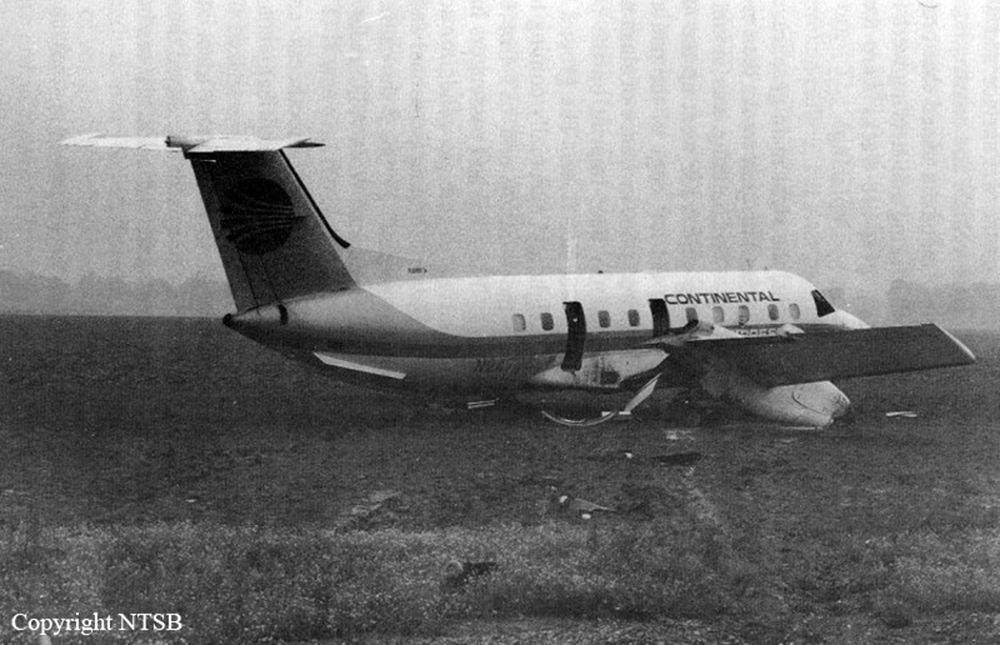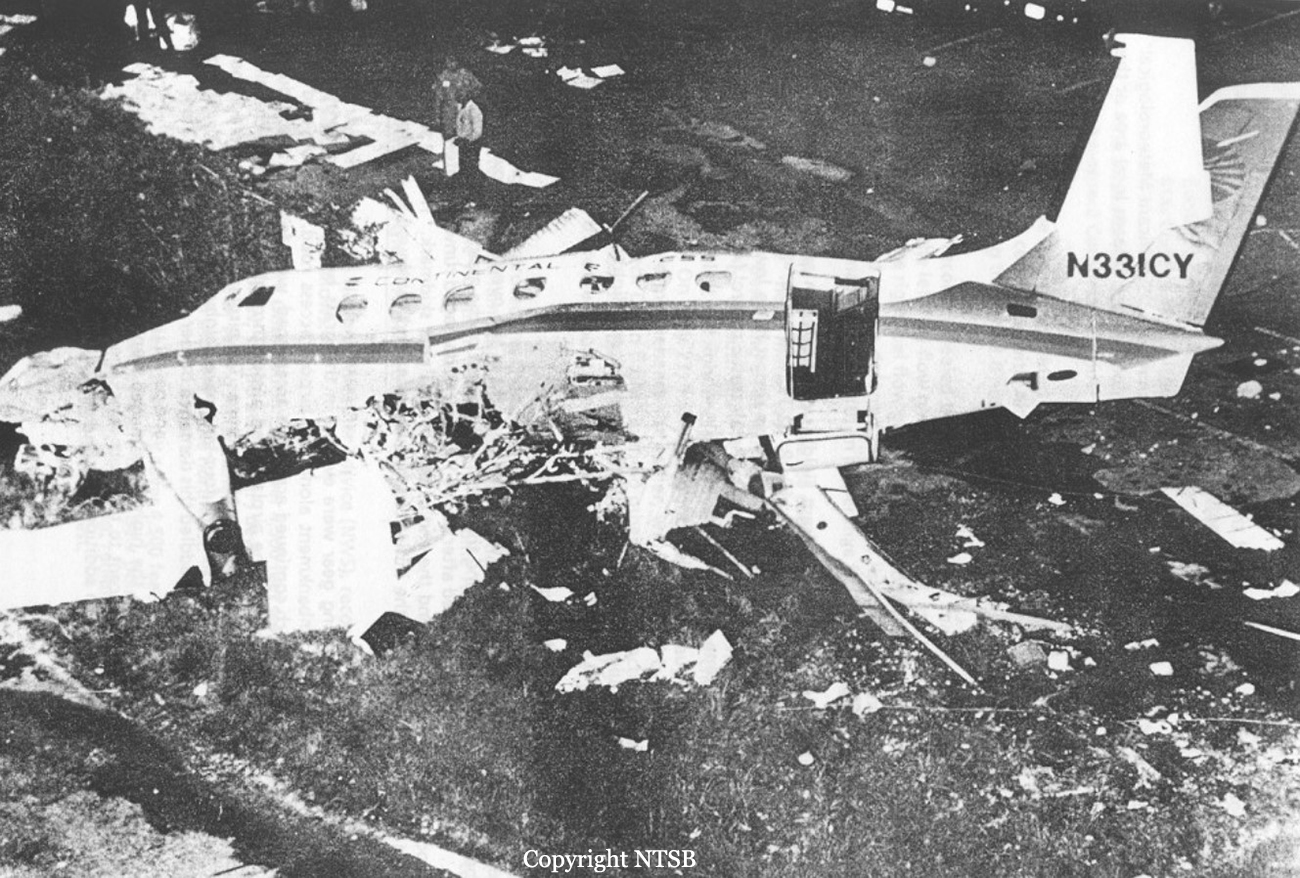Country
Operator Image

Crash of an Embraer ERJ-145 in Beaumont
Date & Time:
Feb 11, 1998 at 1216 LT
Registration:
N14931
Survivors:
Yes
Schedule:
Beaumont - Beaumont
MSN:
145-013
YOM:
1997
Flight number:
CO910
Crew on board:
4
Crew fatalities:
Pax on board:
0
Pax fatalities:
Other fatalities:
Total fatalities:
0
Captain / Total hours on type:
800.00
Copilot / Total hours on type:
15
Aircraft flight hours:
1844
Aircraft flight cycles:
1472
Circumstances:
The pilot-in-command (PIC) was administering a proficiency check flight to the first officer (FO) in a regional jet. One of the required check items was the loss of an engine at "V1" speed. While on takeoff roll with the FO at the controls, the PIC retarded the left engine throttle to idle when "V1" speed was attained. The FO called, "check max thrust," and then called, "positive rate gear up." As the PIC reached for the gear lever, he noticed the airplane roll to the left at a rate which he felt was "excessive and dangerous." He then reached for the flight controls and felt the left rudder "go all the way to the floor." As the PIC took control of the airplane, he applied full right rudder and right aileron. The airplane began recovering from the bank and impacted the ground. Flight recorder data revealed that the time interval between the throttle retarded to idle and ground impact was about 8 seconds. The data showed that the airplane became airborne about 2 seconds after the throttle was retarded, and that the airplane had rolled to a 71 degree left bank within 6 seconds from the throttle reduction. Ground scars and wreckage distribution revealed that the left wing had contacted the ground first and then the right wing prior to the airplane coming to rest. The FO had a total of 15 hours in the type aircraft in the last 90 days. Examinations of the airframe, engines, and flight control system did not reveal any anomalies that could have contributed to the accident. Company flight training policy stated that all check airmen should be ready to take control of the airplane while practicing these types of training maneuvers.
Probable cause:
The first officer's improper use of the rudder when given a simulated engine failure on takeoff and the pilot-in-command's delayed remedial action which resulted in a loss of control. A factor was the first officer's lack of experience in the regional jet airplane.
Final Report:
Crash of an Embraer EMB-120RT Brasília in Pine Bluff
Date & Time:
Apr 29, 1993 at 1555 LT
Registration:
N24706
Survivors:
Yes
Schedule:
Little Rock - Houston
MSN:
120-093
YOM:
1988
Flight number:
CA2733
Crew on board:
3
Crew fatalities:
Pax on board:
27
Pax fatalities:
Other fatalities:
Total fatalities:
0
Captain / Total hours on type:
2600.00
Copilot / Total hours on type:
700
Aircraft flight hours:
10398
Circumstances:
In climb, captain (pic) increased pitch, when flight attendant (f/a) entered cockpit and suggested faster climb, so she could begin cabin service. Autoflight was set in pitch and heading modes, contrary to company policy. Pic and f/a had non- pertinent conversation for 4.5 min, while 1st officer (f/o) was making log entries. Airplane stalled in IMC at 17,400 feet. Initial recovery was at 6,700 feet after f/o lower gear, then due to improper recovery, 2nd stall occurred and recovery was at 5,500 feet. Left propeller shed 3 blades, left engine cowling separated, left engine was shut down in descent. Level flight could not be maintained and forced landing was made at closed airport. Pic overshot final turn due to controllability problems and landed fast with 1,880 feet of wet runway remaining. Airplane hydroplaned off runway and was further damaged. Crew got limited sleep during 3 day trip, though rest periods available. Freezing level near 11,500 feet, clouds tops to 21,000 feet with potential for icing to 19,000 feet. No pre-accident malfunction was found.
Probable cause:
The captain's failure to maintain professional cockpit discipline, his consequent inattention to flight instruments and ice accretion, and his selection of an improper autoflight vertical mode, all of which led to an aerodynamic stall, loss of control, and a forced landing. Factors contributing to the accident were: poor crew discipline, including flightcrew coordination before the stall and the flightcrew's inappropriate actions to recover from the loss of control. Also contributing to the accident was fatigue induced by the flightcrew's failure to properly manage provided rest periods.
Final Report:


Crash of an Embraer EMB-120RT Brasília in Eagle Lake: 14 killed
Date & Time:
Sep 11, 1991 at 1003 LT
Registration:
N33701
Survivors:
No
Schedule:
Laredo - Houston
MSN:
120-077
YOM:
1987
Flight number:
CO2574
Crew on board:
3
Crew fatalities:
Pax on board:
11
Pax fatalities:
Other fatalities:
Total fatalities:
14
Captain / Total hours on type:
2468.00
Copilot / Total hours on type:
1066
Aircraft flight hours:
7229
Aircraft flight cycles:
10009
Circumstances:
The airplane broke up in flight while descending from FL240. The horizontal stabilizer, or top of the T-type tail, had separated from the fuselage before ground impact. Examination revealed that the 47 screw fasteners that would have attached the upper surface of the leading edge assembly for the left side of the horizontal stabilizer were missing. They had been removed the night before during scheduled maintenance. Investigation revealed that there was a lack of compliance with the FAA-approved general maintenance manual procedures by the mechanics, inspectors, and supervisors responsible for assuring the airworthiness of the airplane the night before the accident. In addition, routine surveillance of the continental express maintenance department by the FAA was inadequate and did not detect deficiencies, such as those that led to this accident. All 14 occupants were killed.
Probable cause:
The failure of continental express maintenance and inspection personnel to adhere to proper maintenance and quality assurance procedures for the airplane's horizontal stabilizer deice boots that led to the sudden in-flight loss of the partially secured left horizontal stabilizer leading edge and the immediate severe nose down pitchover and breakup of the airplane. Contributing to the cause of the accident was the failure of continental express management to ensure compliance with the approved maintenance procedures, and the failure of the faa surveillance to detect and verify compliance with approved procedures.
Final Report:
Crash of a BAe 3101 Jetstream 31 in New Orleans
Date & Time:
May 26, 1987 at 1645 LT
Registration:
N331CY
Survivors:
Yes
Schedule:
New Orleans - Valparaiso
MSN:
742
YOM:
1987
Flight number:
CO962
Crew on board:
2
Crew fatalities:
Pax on board:
9
Pax fatalities:
Other fatalities:
Total fatalities:
0
Captain / Total hours on type:
60.00
Copilot / Total hours on type:
18
Aircraft flight hours:
147
Circumstances:
Taxi clearance was received at 16:35 and the flight left gate 14B for runway 19. The airplane was cleared for takeoff at 16:44. Shortly after lifting off, at 200 feet above the ground, the engine torque gauges began to fluctuate erratically and the plane began to yaw back and forth. The captain believed the TTL (Torque Temperature Limiting) system may have been bypassing fuel to the engines (a situation that could occur when power levers are advanced too far forward). He then slightly decreased the power settings which resulted in even greater torque oscillations and greater yawing. The captain believed both engines were malfunctioning for some unknown reason and landed back on runway 19, because a 90° turn for runway 28 seemed impossible. The aircraft overran the runway, struck a 6 feet high chain link fence, struck a concrete barrier and skidded across the Route 61 highway before coming to rest on a parking lot.
Probable cause:
A breakdown of the flight crew coordination which resulted in their failure to comply with the Before Takeoff Checklist and advance the RPM levers to the high RPM position, and the flight crew's failure to diagnose and remedy engine oscillations on initial climbout. Contributing to the flight crew's failure to advance the RPM levers before take off was the fact that both crew members had limited experience in the BAe-3101 and extensive recent experience in other aircraft which use RPM control lever procedures that are different from the BAe-3101."
Final Report:
